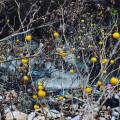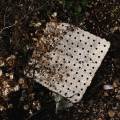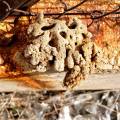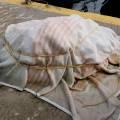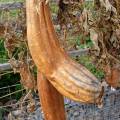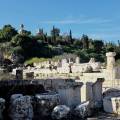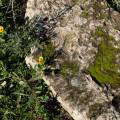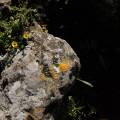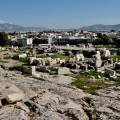Elefsina 2021
In Elefsina, nothing is what it looks like.
The cloudmaking factory (on the plane, check Cloud ijn a Box),
Eucalyptus trees, many many. Eucalyptus paper. Bioplastic with Eucalyptus.
Persephone and Demeter.
Demeter is the goddess of the grain, agriculture, harvest, growth, and nourishment, who presided over grains and the fertility of the earth.
Though Demeter is often described simply as the goddess of the harvest, she presided also over the sacred law, and the cycle of life and death. She and her daughter Persephone were the central figures of the Eleusinian Mysteries, a religious tradition that predated the Olympian pantheon, and which may have its roots in the Mycenaean period c. 1400–1200 BC.[4] Demeter was often considered to be the same figure as the Anatolian goddess Cybele, and in Rome she was identified as the Latin goddess Ceres.
Demeter was frequently associated with images of the harvest, including flowers, fruit, and grain. She was also sometimes pictured with her daughter Persephone. Demeter is not generally portrayed with any of her consorts; the exception is Iasion, the youth of Crete who lay with her in a thrice-ploughed field, and was sacrificed afterwards by a jealous Zeus with a thunderbolt.
In epic poetry and Hesiod's Theogony, Demeter is the Corn-Mother, the goddess of cereals who provides grain for bread and blesses its harvesters. This was her main function at Eleusis, and became panhellenic. In Cyprus, “grain-harvesting” was damatrizein. The main theme in the Eleusinian mysteries was the reunion of Persephone with her mother Demeter, when new crops were reunited with the old seed, a form of eternity.
Demeter's emblem is the poppy, a bright red flower that grows among the barley.[25]
Demeter's epithets show her many religious functions. She was the “Corn-Mother” who blesses the harvesters. Some cults interpreted her as “Mother-Earth”. Demeter may be linked to goddess-cults of Minoan Crete, and embody aspects of a pre-Hellenic Mother Goddess.[35] It is possible that the title “Mistress of the labyrinth”, which appears in a Linear B inscription, belonged originally to Sito (“[she] of the grain”), the Great Mother Demeter and that in the Eleusinian mysteries this title was kept by her daughter Persephone (Kore or Despoina).
Major cults to Demeter are known at Eleusis in Attica
Demeter's two major festivals were sacred mysteries. Her Thesmophoria festival (11–13 October) was women-only.[54] Her Eleusinian mysteries were open to initiates of any gender or social class. At the heart of both festivals were myths concerning Demeter as Mother and Persephone as her daughter.
Demeter's most well-known relationship is with her daughter, Persephone, goddess of the underworld. Both Homer and Hesiod described Persephone's father as Zeus' daughter.[62] Before her abduction by Hades, Persephone was known as Kore (“maiden”), and there is some evidence that the figures of Persephone Queen of the Underworld and Kore daughter of Demeter were originally considered separate goddesses.
Demeter and Persephone
Demeter's daughter Persephone was abducted to the underworld by Hades. Demeter searched for her ceaselessly, preoccupied with her loss and her grief. The seasons halted; living things ceased their growth, then began to die.[71] Faced with the extinction of all life on earth, Zeus sent his messenger Hermes to the underworld to bring Persephone back. Hades agreed to release her if she had eaten nothing while in his realm; but Persephone had eaten a small number of pomegranate seeds. This bound her to Hades and the underworld for certain months of every year, either the dry Mediterranean summer, when plant life is threatened by drought,[72] or the autumn and winter.[73] There are several variations on the basic myth. In the Homeric hymn to Demeter, Hecate assists in the search and later becomes Persephone's underworld attendant.[74] In another, Persephone willingly and secretly eats the pomegranate seeds, thinking to deceive Hades, but is discovered and made to stay. Contrary to popular perception, Persephone's time in the underworld does not correspond with the unfruitful seasons of the ancient Greek calendar, nor her return to the upper world with springtime.[75] Demeter's descent to retrieve Persephone from the underworld is connected to the Eleusinian Mysteries.
The myth of the capture of Persephone seems to be pre-Greek. In the Greek version, Ploutos (πλούτος, wealth) represents the wealth of the corn that was stored in underground silos or ceramic jars (pithoi). Similar subterranean pithoi were used in ancient times for funerary practices. At the beginning of the autumn, when the corn of the old crop is laid on the fields, she ascends and is reunited with her mother Demeter, for at this time the old crop and the new meet each other.[76]
Demeter at Eleusis
Eleusinian trio: Persephone, Triptolemos, and Demeter, on a marble bas-relief from Eleusis, 440–430 BC
Relief of Demeter in Pompeii referencing her ancient status of mother goddess and goddess of agriculture
Demeter's search for her daughter Persephone took her to the palace of Celeus, the King of Eleusis in Attica. She assumed the form of an old woman, and asked him for shelter. He took her in, to nurse Demophon and Triptolemus, his sons by Metanira. To reward his kindness, she planned to make Demophon immortal; she secretly anointed the boy with ambrosia and laid him in the flames of the hearth, to gradually burn away his mortal self. But Metanira walked in, saw her son in the fire and screamed in fright. Demeter abandoned the attempt. Instead, she taught Triptolemus the secrets of agriculture, and he in turn taught them to any who wished to learn them. Thus, humanity learned how to plant, grow and harvest grain. The myth has several versions; some are linked to figures such as Eleusis, Rarus and Trochilus. The Demophon element may be based on an earlier folk tale.[80]
https://en.wikipedia.org/wiki/Demeter
reminders to work on:
- Demeter, harvest & honeybees
- connection Elefsina/Brussels, Connected OpenGreens IGB
- Eucalyptus trees (many many many) - work with the bark as a renewal material (paper, bioplastic, …)

